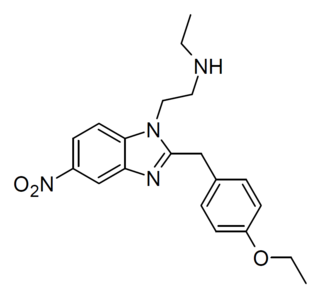
Dihydroetorphine was developed by K. W. Bentley at McFarlan-Smith in the 1960s and is a potent opioid analgesic used mainly in China. It is a derivative of the better-known opioid etorphine, a very potent veterinary painkiller and anesthetic medication used primarily for the sedation of large animals such as elephants, giraffes, and rhinos.

AH-7921 is an opioid analgesic drug selective for the μ-opioid receptor, having around 90% the potency of morphine when administered orally. It was discovered in the 1970s by a team at Allen and Hanburys located in the United Kingdom. The drug is considered a new psychoactive substance (NPS) in which it is synthetically created in laboratories to mimic that of controlled substances. The substance has also been sold on the internet since 2012 as a "research chemical". When sold online it may be called the alternative name doxylam, not to be confused with doxylamine. AH-7921 has never progressed to clinical trials. The DEA is not aware of any medical usage in the United States, and has not insisted the Health and Human Services department (HHS) to conduct any medical research of the substance's uses.

U-47700, also known as U4, pink heroin, pinky, and pink, is an opioid analgesic drug developed by a team at Upjohn in the 1970s which has around 7.5 times the potency of morphine in animal models.

Acetylfentanyl is an opioid analgesic drug that is an analog of fentanyl. Studies have estimated acetylfentanyl to be 15 times more potent than morphine, which would mean that despite being somewhat weaker than fentanyl, it is nevertheless still several times stronger than pure heroin. It has never been licensed for medical use and instead has only been sold on the illicit drug market. Acetylfentanyl was discovered at the same time as fentanyl itself and had only rarely been encountered on the illicit market in the late 1980s. However, in 2013, Canadian police seized 3 kilograms of acetylfentanyl. As a μ-opioid receptor agonist, acetylfentanyl may serve as a direct substitute for oxycodone, heroin or other opioids. Common side effects of fentanyl analogs are similar to those of fentanyl itself, which include itching, nausea and potentially fatal respiratory depression. Fentanyl analogs have killed hundreds of people throughout Europe and the former Soviet republics since the most recent resurgence in use began in Estonia in the early 2000s, and novel derivatives continue to appear.

Furanylfentanyl (Fu-F) is an opioid analgesic that is an analog of fentanyl and has been sold as a designer drug. It has an ED50 value of 0.02 mg/kg in mice. This makes it approximately one fifth as potent as fentanyl.

Bucinnazine is an opioid analgesic drug that was widely used in China to treat pain in cancer patients as of 1986. It is one of the most potent compounds among a series of piperazine-amides first synthesized and reported in Japan in the 1970s. Bucinnazine has analgesic potency comparable to that of morphine but with a relatively higher therapeutic index.

Metonitazene is an analgesic compound related to etonitazene, which was first reported in 1957, and has been shown to have approximately 1000 times the potency of morphine by central routes of administration, but if used orally it has been shown to have approximately 10 times the potency of morphine.

Isotonitazene is a benzimidazole-derived opioid analgesic drug related to etonitazene, which has been sold as a designer drug. It has only around half the potency of etonitazene in animal studies, but it is likely even less potent in humans as was seen with etonitazene. Isotonitazene was fully characterized in November 2019 in a paper where the authors performed a full analytical structure elucidation in addition to determination of the potency at the μ-opioid receptor using a biological functional assay in vitro. While isotonitazene was not compared directly to morphine in this assay, it was found to be around 2.5 times more potent than hydromorphone and slightly more potent than fentanyl.

Brorphine is a piperidine-based opioid analgesic compound. Brorphine was originally discovered in a 2018 paper investigating functionally biased opioid compounds, with the intention of finding safer analgesics that produce less respiratory depression than typical opioids. Brorphine was originally reported to be highly biased, with an EC50 of 4.8nM for GTPγS binding and 182nM for β-arrestin recruitment, however a more recent study found no significant bias for any of the compounds tested, including brorphine. Its safety profile in any animal model has never been established. Despite the lack of safety information on the compound, brorphine has been sold as a designer drug since mid-2019, initially being identified in the US Midwest, though it has since been found in 2020 in Belgium. It is related in chemical structure to compounds such as benzylfentanyl and bezitramide, though it is sufficiently structurally distinct to fall outside the formal definition of a "fentanyl analogue" in jurisdictions such as the US and New Zealand which have Markush structure controls over this family of drugs.

Etodesnitazene is a benzimidazole derived opioid analgesic drug, which was originally developed in the late 1950s alongside etonitazene and a range of related derivatives. It is many times less potent than etonitazene itself, but still 70x more potent than morphine in animal studies. Corresponding analogues where the N,N-diethyl group is replaced by piperidine or pyrrolidine rings also retain significant activity. Etodesnitazene has been sold as a designer drug, first being identified in both Poland and Finland in March 2020.

Etonitazepyne is a benzimidazole derivative with potent opioid effects which has been sold over the internet as a designer drug and linked to numerous cases of overdose.

AP-238 is an opioid designer drug related to drugs such as azaprocin and bucinnazine, with around the same potency as morphine. It was first discovered in Italy in the 1960s but was never marketed, subsequently appearing on the illicit market around 2020 and being detected in both Slovenia and the USA.

Etonitazepipne is a benzimidazole derivative with opioid effects around 100 times more potent than morphine, which has been sold over the internet as a designer drug.

Metodesnitazene is a benzimidazole derivative with opioid effects, though unlike related compounds such as metonitazene and etodesnitazene which are many times more potent, metodesnitazene is only around the same potency as morphine in animal studies. It was proposed by the DEA to be placed under legal control in the US in December 2021.

Butonitazene is a benzimidazole derivative with opioid effects, which has been sold over the internet as a designer drug. It has relatively low potency compared to many related compounds, and has generally been encountered as a component of mixtures with other substances rather than in its pure form. However, it is still several times the potency of morphine and has been implicated in several cases of drug overdose. Butonitazene is a Schedule I drug in the US, along with several related compounds.

N-Desethylisotonitazene (Norisotonitazene) is a benzimidazole derivative with potent opioid effects which has been sold as a designer drug. It was first identified as an active metabolite of the related compound isotonitazene, but was unexpectedly found to be similar potency compared to the parent compound, and is among the most potent opioid agonists in this family, around 20 times stronger than fentanyl. It has become an increasingly widespread drug of abuse in its own right, linked to numerous cases of drug overdose,and may be considered an analog of a schedule 1 drug in the US. On October 25 an intent to temporarily schedule Etonitazepipne and N-desethyl Isotonitazene was published. So on November 24 a month after publishing intent, it will most likely be placed in schedule 1.

N-Desethyletonitazene is a benzimidazole derivative with potent opioid effects which has been sold as a designer drug. It is better known as an active metabolite of the related compound etonitazene, but has similar activity to the parent compound and has sometimes appeared as a drug of abuse in its own right.

U-48800 is an opioid analgesic which has been sold as a designer drug. Unlike U-47700, it is primarily active as a kappa opioid receptor agonist with only moderate affinity at the mu opioid receptor. Nevertheless, it has still appeared on the recreational drug market, often as a component of combinations with other drugs, and has been linked to numerous drug overdose cases.

Flunitazene (Fluonitazene) is a benzimidazole derivative with opioid effects, first developed in the 1950s as part of the research that led to better-known compounds such as etonitazene. It is one of the least potent derivatives from this class to have appeared as a designer drug, with only around the same potency as morphine, but nevertheless has been sold since around 2020, and has been linked to numerous drug overdose cases.



















